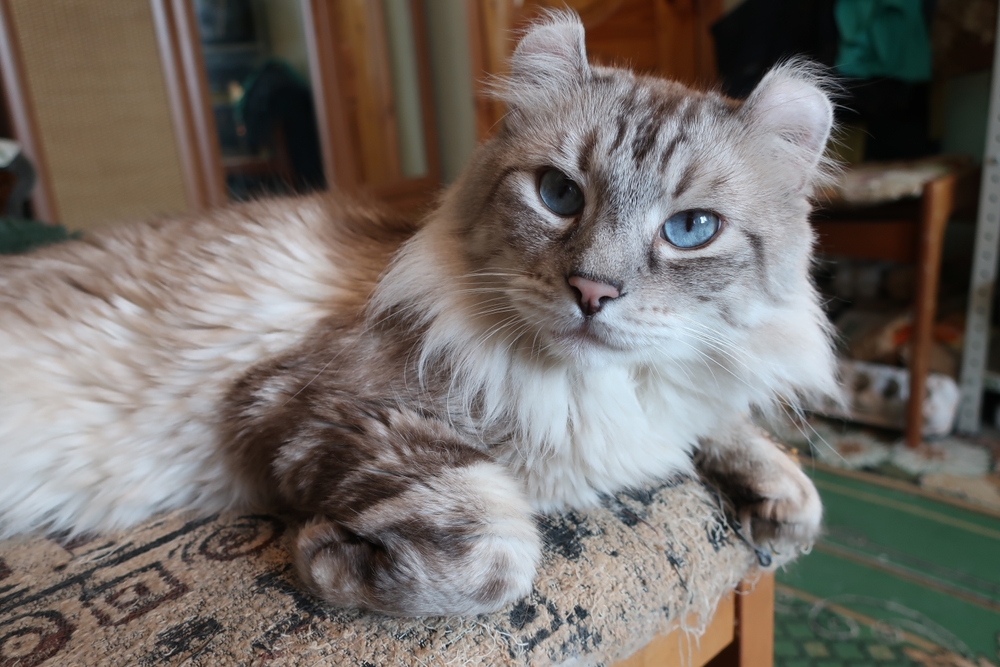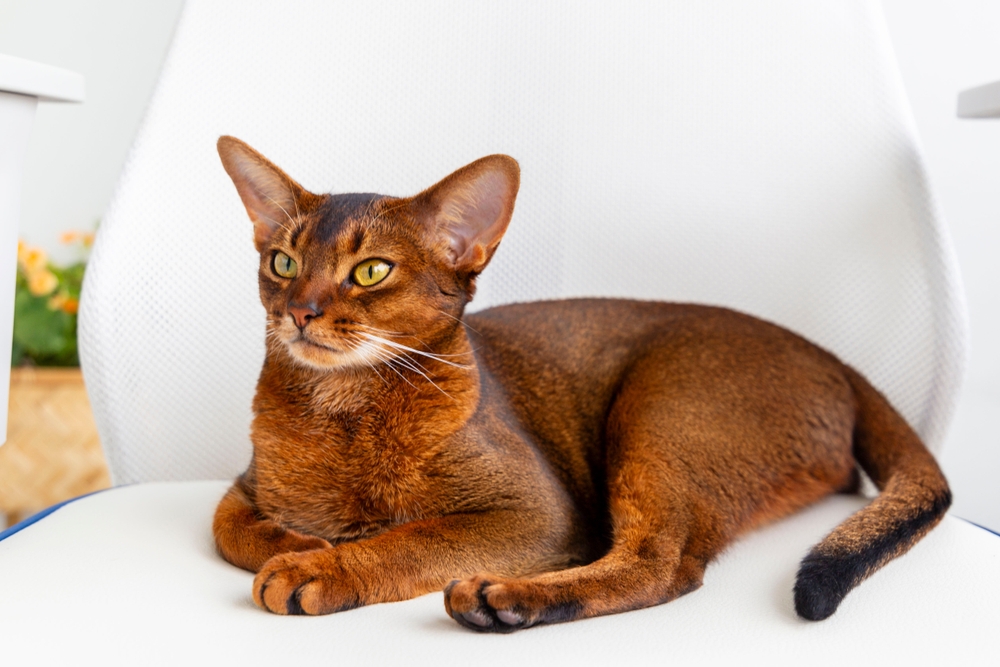The closest in temperament and general build is the American Shorthair or American Longhair, depending on the Curl’s coat type. However, the American Curl’s unique ear shape sets it apart from all other breeds, with no direct natural counterpart.
About
The American Curl is a charming, medium-sized cat breed instantly recognizable for its unique backward-curled ears. This distinct feature results from a natural genetic mutation and gives the breed a perpetually alert, inquisitive expression. The ears curl in a graceful arc away from the face, with the tips ideally forming a smooth, rounded shape. Aside from this hallmark trait, American Curls have a well-balanced, semi-foreign body type, silky coats that can be short or long, and come in virtually any color or pattern.
The American Curl (Felis catus), a member of the family Felidae, originated in Lakewood, California, in 1981 when a stray black, long-haired female with curled ears—named Shulamith—was adopted by a local family. All modern American Curls trace their lineage to her. Selective breeding preserved the ear curl while maintaining genetic diversity, resulting in a healthy and adaptable breed.
These cats typically weigh between 5–10 pounds (2.3–4.5 kg) and are known for their friendly, people-oriented personalities. They tend to remain playful and kitten-like well into adulthood, enjoying interactive games and companionship. American Curls are affectionate without being overly demanding, often following their humans around and greeting them at the door.
Their coats require minimal grooming—shorthaired Curls need occasional brushing, while longhaired ones benefit from weekly grooming to prevent tangles. The ear cartilage is delicate, so handling the ears should be done gently to avoid injury.
American Curls are adaptable to a variety of living environments and generally get along well with children, other cats, and even cat-friendly dogs. With their distinctive look, gentle temperament, and enduring playfulness, they make excellent companions for families and individuals alike.
Physical Characteristics
Coat: The American Curl’s most distinctive feature is not its coat, but its ears. The coat itself can be short or long, with a soft, silky texture that lies flat against the body. It comes in nearly every possible cat color and pattern, including solid, tabby, bicolor, and pointed varieties.
Face: They have a moderately wedge-shaped head with gentle curves, giving a sweet and alert expression. The eyes are walnut-shaped—slightly oval on top and round on the bottom—and can be any color, often complementing the coat.
Ears: Their hallmark trait is the unique backward curl of the ears. The curl begins at the base and sweeps back in an arc of 90° to 180°. The ears are firm at the base but flexible at the tips, with tufts of fur often sprouting from inside.
Body: Medium-sized, semi-foreign in type—graceful yet muscular. The body is well-balanced and proportionate, with a level back and rounded contours.
Tail: Long and flexible, matching the body length, and fully plumed in longhaired varieties.
Size:
-
Length: About 12–16 in (30–41 cm) from head to base of tail.
-
Height: Around 9–10 in (23–25 cm) at the shoulder.
Weight:
-
Adult Female: 5–8 lbs (2.3–3.6 kg).
-
Adult Male: 7–10 lbs (3.2–4.5 kg).
The American Curl’s combination of expressive walnut-shaped eyes, silky coat, and signature curled ears creates a unique, permanently “curious” look that sets it apart from all other cat breeds.
Reproduction
Mating and Courtship:
American Curls reach sexual maturity at around 6–10 months of age. Mating behaviors in females include increased vocalization, affectionate rubbing, and assuming the lordosis posture. Males respond with courtship actions such as following, nuzzling, and soft vocalizations.
Breeding Season:
They can breed year-round, though queens may cycle more often in spring and summer when daylight hours are longer.
Gestation:
Pregnancy lasts about 63–68 days (roughly 9 weeks).
Birth of Kittens:
A typical litter size is 3–5 kittens, though litters can range from 1 to 7. Kittens are born with straight ears, and the signature curl begins to appear within 3–5 days. The curl reaches its permanent shape by about 16 weeks of age.
Care and Nurturing:
Kittens are born weighing around 3–4 oz (85–113 g), with eyes closed and completely dependent on their mother. Queens provide warmth, nursing, and grooming, keeping the kittens in a safe, quiet nesting area.
Weaning and Social Development:
-
Eyes open at about 7–10 days.
-
Kittens start walking at 3 weeks and nibbling on solid food by 4–5 weeks.
-
Weaning is generally complete by 8–10 weeks.
Independence:
By 12–14 weeks, kittens are ready for adoption. Breeders often recommend keeping them with their littermates until at least 12 weeks to ensure proper emotional and social development.
The American Curl’s reproductive cycle follows typical domestic cat patterns, but their ear curl development is a unique breed hallmark that requires monitoring to ensure healthy cartilage formation in growing kittens.
Lifespan
Lifespan in the Home:
American Curls are generally healthy and long-lived, with an average lifespan of 12–16 years. Many live to 17–20 yearswhen provided with proper nutrition, veterinary care, and a safe indoor environment.
Lifespan in Outdoor or High-Risk Settings:
Outdoor American Curls face increased risks from accidents, predators, infectious diseases, and harsh weather, often reducing their lifespan to 6–10 years.
Factors Affecting Longevity:
-
Genetics: The gene responsible for curled ears is not linked to major health issues, but responsible breeding is important to avoid cartilage problems.
-
Nutrition & Exercise: A balanced, high-protein diet and interactive play help maintain a healthy weight and muscle tone.
-
Preventive Care: Regular checkups, vaccinations, dental care, and parasite prevention contribute to longer, healthier lives.
-
Environment: Indoor living with enrichment (scratching posts, climbing trees, toys) promotes mental and physical well-being.
Notable Longevity:
Some American Curls have been documented living well past 20 years, especially in calm, loving homes with attentive care.
The American Curl’s robust health, playful nature, and adaptability contribute to its reputation as a long-lived, low-maintenance breed when raised in a safe, enriched environment.
Eating Habits
Diet:
American Curls are obligate carnivores and thrive on a diet rich in high-quality animal protein. Premium commercial cat food—wet, dry, or a combination—should meet AAFCO (Association of American Feed Control Officials) feline nutritional standards. Wet food supports hydration and urinary health, while dry kibble can help maintain dental cleanliness.
Feeding Frequency:
-
Kittens (up to 6 months): 3–4 small meals daily to support rapid growth.
-
Adults (6 months–10 years): 2–3 meals daily, adjusted for activity level.
-
Seniors (10+ years): Smaller, more frequent meals, often with senior formulas to support joint, kidney, and heart health.
Special Considerations:
-
American Curls are generally active and playful, so they require enough calories to maintain muscle mass without becoming overweight.
-
They may enjoy a variety of protein sources such as chicken, turkey, fish, and beef, but dietary changes should be gradual to avoid digestive upset.
-
Fresh, clean water should be available at all times, as adequate hydration is critical to kidney and urinary tract health.
Treats:
Healthy treats such as freeze-dried meat or small portions of cooked poultry or fish can be given in moderation, keeping treats under 10% of daily calorie intake.
Feeding Enrichment:
Because they are intelligent and curious, American Curls often enjoy puzzle feeders, slow-feeding bowls, or interactive treat toys that engage their hunting instincts and mental stimulation.
The American Curl’s eating habits reflect a balance of nutrition, variety, and activity—keeping them lean, energetic, and healthy throughout their life.
Uniqueness
Signature Curled Ears:
The breed’s defining feature is its backward-curling ears, caused by a natural genetic mutation. The curl begins to form a few days after birth and reaches its permanent shape by 16 weeks.
Wide Variety in Appearance:
American Curls can have either short or long coats and come in nearly every color and pattern, from solid to tabby to pointed, making each cat visually distinct.
Gentle Temperament:
They are known for being affectionate, social, and adaptable, getting along well with children, other cats, and even cat-friendly dogs.
Kitten-Like Personality for Life:
American Curls retain a playful, curious nature well into adulthood and old age, often described as “eternal kittens” by their owners.
Healthy and Hardy:
The curl gene is not linked to serious health defects, making the breed generally robust with few genetic disorders compared to some pedigreed cats.
Origin Story:
The breed originated in 1981 in California when a stray cat with unusual curled ears was adopted by a family, eventually becoming the foundation of the breed.
Global Recognition:
Despite being a relatively new breed, the American Curl has quickly gained recognition from major cat associations, admired for both its beauty and friendly disposition.
The American Curl’s combination of rare ear shape, diverse coat possibilities, and enduringly playful personality makes it one of the most distinctive and charming cat breeds in the world.
Be the First to Share Photos of This Species.
FAQ’s
1. What is the closest species or breed to the American Curl?
2. How does the American Curl compare to other cats?
Compared to other breeds, the American Curl is highly adaptable, friendly, and retains a playful, kitten-like personality throughout life. While many cats slow down with age, Curls remain curious and active. Their curled ears add a distinctive, alert expression unmatched by other breeds
3. What national parks or regions provide the best chance to see a cat resembling the American Curl?
Since no wild cat has the signature curled ears, the closest resemblance in the wild would be in body type and temperament. Cats similar in build—such as small wildcats—can be seen in:
-
Channel Islands National Park, California – Home state of the breed’s origin, where feral domestic cats may be spotted.
-
Santa Monica Mountains National Recreation Area, California – Known for sightings of feral domestic cats and bobcats with similar slender builds.
-
Point Reyes National Seashore, California – Occasionally home to domestic cats with varied coat patterns, similar to the Curl’s diversity.




































































